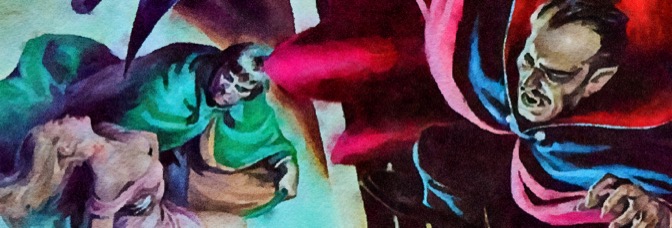
I’m getting to be such a Mike Ploog snob. Seeing him ink his own pencils, then seeing others ink his pencils… the latter always seems to come with qualifications, asterisks, and compromises. Ploog pencils this issue’s first story, written by Marv Wolfman, with Ernie Chan inking him. Chan keeps much of the detail, even much of the personality, but not the energy.
The story’s about one Louis Belski, Dracula actor. I thought Wolfman was doing a riff on Bela Lugosi: switching the initials, portraying the actor in his has-been days, ready for Ed Wood to show up with an offer, but apparently not. Belski’s instead just a hack who never achieved the greatness of Lugosi, John Carradine, or Christopher Lee—according to Dracula himself, who’s come to Hollywood to stop Belski from continuing his career.
His career’s incredibly long; Belski started at the studio when it was constructed in 1927. It’s the early seventies; the actor’s apparently in his early to mid-sixties, which kind of explains why he’s not doing well in the part. He’s also a raging drunk who starts pretending he’s really Dracula after shooting’s stopped, attacking those who wrong him, and trying to seduce an ingénue. So the actual Count doesn’t just have to contend with an obnoxious actor; he’s also got to intercede in that actor’s drunken, murderous rampage.
It’s a jam-packed story, with Wolfman sort of overwriting it but never thinking about it—Belski’s age, for instance, but then also the idea Dracula got his stake pulled in Tomb and went out to revival theaters to catch up on how he’d been portrayed in popular media. Also, Belski’s a lousy lead to follow around. It’s like a horror comic where you’re waiting for the villain’s comeuppance, but the collateral damage on the comeuppance is almost too much.
While not bad, it’s definitely disappointing. Especially for the only Ploog in Dracula Lives so far.
Then there are some text pieces; lots of text pieces this issue. And the movie stills with new text are back, though not as jokey as they’ve been before. Now they’re just interstitials. The first two text pieces are a book review about the real Dracula from Chris Claremont. The book’s called In Search of Dracula (and appears to still be in print if one’s interested), but the review’s way too overwrought with Claremont trying to be personable, then the typesetting on movie stills makes it hard to read.
Then Dwight R. Decker contributes a one-page joke vacation text about real Romania? It’s too bad the filler’s not better in Lives. Especially since they appear to be upping the text and lowering the reprint count. There are only two reprint stories.
The first is about a village where everyone thinks this lovely lady is a vampire seducing the local boys, then killing them. The truth’s more complicated and not particularly rewarding, but Joe Maneely’s art’s really good, and it’s only six pages.
The following story is another original (thank goodness they’re still doing three an issue). Gardner Fox writes, Dick Ayers does the art. It’s Dracula versus Countess Elizabeth Báthory. She’s the one who bathed in human blood to stay young. Dracula doesn’t like her getting in on his business, especially when she’s a poser. It’s a tedious twelve pages, partially because the idea’s one-note, but also because Fox’s script isn’t great, and then the Ayers art is a considerable downgrade from the rest in the issue. Not just the new features either, the reprints as well.
Then comes a couple more text pieces. One’s a jokey biography of Marv Wolfman, and the other’s a review of Horror of Dracula by Gerry Boudreau. It’s more a combination of behind-the-scenes and scene-by-scene recap with some scant critical commentary. They threaten more reviews at the end.
The second reprint is a short one, art by Tony Mortellaro, and it seems like they should’ve run it in the first issue because it’s so well-suited for Lives. A German villager only wants his daughter to marry royalty, so he kills off her poor suitors, sometimes letting vampires feed on them for cover. Despite his daughter wanting to choose her own destiny, he decides for her and makes an exceptionally bad selection.
The final story is the third original, written by Gerry Conway (easily his best Dracula in Lives or Tomb and some of his best writing from this era), with art by Vicente Alcazar. Alcazar has maybe two less than perfect panels, but otherwise, the art’s consistently breathtaking.
It’s another of the Dracula origin stories, with the former Impaler retaking his castle from the invading Turks. He’s got to deal with the newly installed regional commander but also the neighborhood Catholic priest who’s got a fairly big secret. Then, of course, there’s still the castle, which the Turks have occupied, and the local girls they’ve enslaved.
The feature’s a page shorter than the issue’s other two—eleven pages instead of twelve—, and it’s a bummer they didn’t give Conway and Alcazar more pages because it’s outstanding. Conway’s characterization of Dracula as vampire king is rather thoughtful, and—given the particulars—Drac gets to be an unproblematic protagonist. Everyone else is doing far worse things than just retaking from occupiers.
Alcazar gets a variety of action to visualize, with Dracula fighting soldiers but also finding himself in his first vampire transformation duel. It’s great.
I had been thinking I’d jump off Dracula Lives after a while, so long as Tomb doesn’t keep citing it; I don’t think I can give it up. Not just for the art either; the Conway writing on the last story is fantastic. Plus, the fifties reprints are surprisingly good. I’d always assumed fifties horror comics would be rote and stale, but nope. They’re succinct enough their initial impulse carries through.
The text material, obviously, is take or leave. Meaning leave.

Leave a Reply